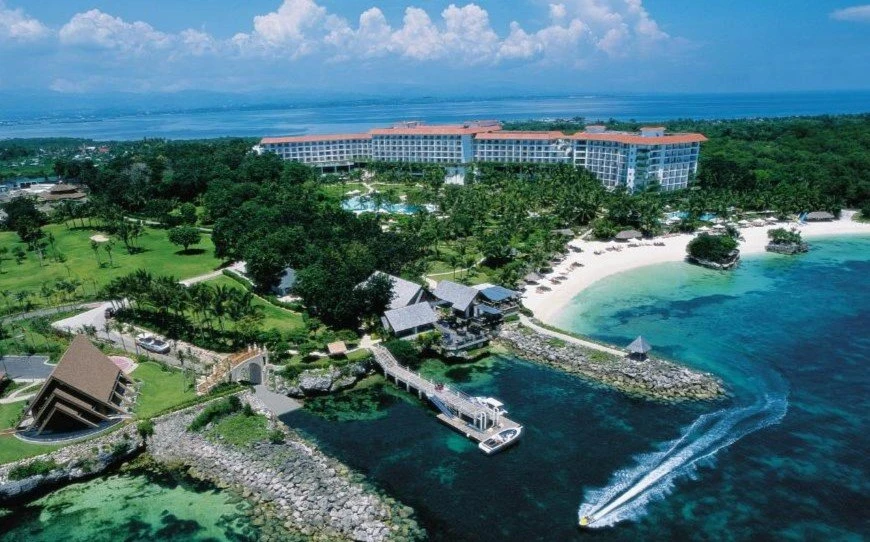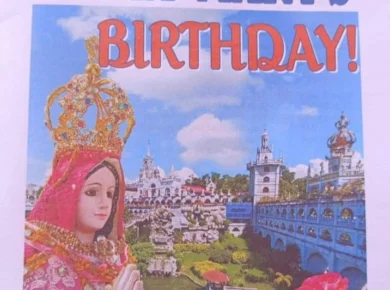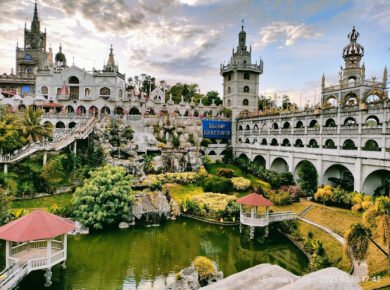Ever dreamed of stepping into a living piece of history? Look no further than the Basilica del Santo Niño in Cebu, Philippines. This iconic church isn’t just another pretty building – it’s the oldest Roman Catholic church in the country, with a story that’ll knock your socks off.
So, are you ready to discover why millions flock here every year? Buckle up, because we’re about to take you on a whirlwind tour of this fascinating landmark. Trust us, by the end of this guide, you’ll be itching to book your ticket to Cebu!
Table of Contents
The History of the Basilica del Santo Niño
Cebu’s Oldest Church
Step into the hallowed grounds of the Basilica del Santo Niño, and you’ll find yourself immersed in centuries of rich history. Founded in 1565, this venerable church holds the distinction of being the oldest Roman Catholic church in the Philippines. As you explore, you’ll discover that the basilica’s roots stretch back to the time of Ferdinand Magellan’s arrival in the archipelago.
Rising from the Ashes
The basilica you see today isn’t the original structure. Like a phoenix, it has risen from the ashes multiple times. The current building, completed in 1740, stands as a testament to resilience and faith. Its architecture blends Muslim, Romanesque, and neo-classical elements, creating a unique and awe-inspiring presence.
The Santo Niño’s Legacy
At the heart of the basilica lies its most treasured possession: the Santo Niño de Cebú. This statue of the Child Jesus, gifted by Magellan in 1521, has become the centerpiece of Cebu’s vibrant religious culture. Every January, the basilica buzzes with energy as it hosts the Sinulog festival, a grand celebration that draws devotees from far and wide.
The Santo Niño Statue
A Symbol of Faith and Culture
The Santo Niño statue holds immense significance as the oldest Christian artifact in the Philippines. This wooden figure of the Child Jesus was originally gifted by Ferdinand Magellan to the local ruler Rajah Humabon and his wife in 1521, marking the introduction of Catholicism to the islands. Over the centuries, it has become deeply ingrained in Filipino culture, serving as a powerful symbol of faith, heritage, and national identity.
The Heart of Sinulog Festival
You’ll find that the Santo Niño is more than just a historical relic – it’s a living part of Filipino Catholic tradition. The statue is the centerpiece of the annual Sinulog festival, drawing millions of devotees to Cebu City each January. During this vibrant celebration, you’ll witness colorful processions, traditional dances, and fervent prayers, all centered around this beloved image.
A Guardian for Devotees
For many Filipinos, the Santo Niño represents divine protection and blessing. The statue is often displayed in homes, businesses, and even public transportation, reflecting its role as a guardian figure in daily life. When you visit the Basilica, you’ll see countless devotees touching or praying before the statue, seeking its intercession in their lives.
What to Expect at the Basilica
A Spiritual Walk Through History
As you step into the Basilica del Santo Niño, prepare to be transported through centuries of Filipino history and faith. This oldest Roman Catholic church in the Philippines houses the revered Santo Niño de Cebu statue, the country’s oldest religious relic. You’ll be captivated by the breathtaking murals and artwork adorning the ceilings and walls, creating a solemn and spiritual atmosphere.
Cultural Experiences Await
During your visit, you might witness the vibrant Sinulog dance performances, a traditional celebration of faith and culture. Don’t miss the chance to explore the Santo Niño Museum, where you can delve deeper into Cebu’s religious history through a collection of artifacts and antique items.
Join Devotional Practices
You’re welcome to attend daily masses, offered in various languages to accommodate diverse visitors. For a more personal experience, light a candle in the serene Candle Chapel and offer your prayers. Remember to dress modestly and respectfully, as shorts, sleeveless tops, and slippers are not allowed inside. Embrace this unique opportunity to immerse yourself in Filipino spirituality and culture.
Marvel at the Architecture
Blending Styles Across Time
As you approach the Basilica del Santo Niño, you’ll be immediately struck by its impressive facade. This architectural masterpiece showcases a stunning baroque style that seamlessly combines elements of Muslim, Romanesque, and neo-classical design. The exterior retains its original stone texture, giving you a tangible connection to its rich history.
A Stunning Exterior
Look up, and you’ll see the intricately designed bell tower reaching towards the sky. This architectural feature, along with the grand facade, enhances the basilica’s magnificence and serves as a testament to the skilled craftsmanship of its builders.
Awe-Inspiring Interiors
Step inside, and you’ll find yourself gazing up at the dome-like ceiling. This feature reflects the influence of Muslim architecture, creating a sense of awe with its intricate details. As a Basilica Minore, this church holds special significance for Catholics worldwide, making it not just an architectural marvel, but a spiritual destination as well.
Despite facing damage from a 2013 earthquake, careful restoration has preserved the basilica’s beauty and historical integrity. As you explore, you’ll see how this unique blend of cultural and religious elements creates a visually stunning landmark that captures the essence of Spanish colonial influence in the Philippines.
Tips for Visiting the Basilica del Santo Niño
Plan Your Trip
When visiting the Basilica del Santo Niño, timing is everything. The church is open daily from 4:30 AM to 9 PM, but Sunday masses tend to be the most crowded. To avoid the rush, consider visiting on a weekday. If you’re flying in, the quickest route is via Mactan-Cebu International Airport, followed by a 30-60 minute taxi or shuttle ride to the basilica.
Dress Appropriately
Remember, this is a place of worship, so dress modestly. Shorts, sleeveless tops, and flip-flops are not allowed. Opt for conservative clothing that covers your shoulders and knees. It’s also wise to avoid bringing large bags or backpacks due to strict security measures.
Explore the Surroundings
Make the most of your visit by exploring nearby attractions. The basilica is within walking distance of other famous landmarks like Magellan’s Cross and Fort San Pedro. Consider taking a guided tour to learn about the rich history of this oldest Roman Catholic church in the Philippines, founded in 1565. Don’t miss the chance to see the original Santo Niño statue, a religious relic with a fascinating story dating back to Magellan’s arrival in 1521.
FAQs about Basilica del Santo Niño
When can I visit the Basilica?
The Basilica Minore del Santo Niño is open daily from 6:00 AM to 7:00 PM, welcoming visitors and pilgrims alike. Admission is free, so you can explore this historic site at your leisure.
What’s the significance of the Santo Niño statue?
The Santo Niño statue is the heart of the Basilica. This revered image was discovered in 1565 by Spanish explorers and is considered the oldest religious relic in the Philippines. It’s survived multiple fires over the centuries, making it a symbol of resilience for many Filipinos.
Can I attend Mass at the Basilica?
Absolutely! The Basilica holds regular Masses in both English and the local Cebuano language. It’s a great way to experience the spiritual atmosphere and join the local community in worship.
What else can I see at the Basilica?
Don’t miss the on-site museum, which showcases the history of Christianity in Cebu. You’ll find fascinating religious artifacts, antique objects, and even a “wishing pool” that some believe has healing powers. The Basilica’s architecture is also a sight to behold, blending Spanish colonial aesthetics with Filipino craftsmanship.


![Travel Guide to Simala Church: Itinerary and Budget [2024] simala church image by Jane Jumaoas](https://hellocebuph.com/wp-content/uploads/2024/02/simala-church-image-by-Jane-Jumaoas-390x290.webp)
![Simala Mass Schedule 2025 [Official Schedule] Monastery of the Holy Eucharist by Mary Loren Capas](https://hellocebuph.com/wp-content/uploads/2025/01/Monastery-of-the-Holy-Eucharist-by-Mary-Loren-Capas-390x290.webp)


![Travel Guide to Basilica del Santo Niño: Itinerary and Budget [2024] Basilica Minore del Santo Nino de Cebu 2018](https://hellocebuph.com/wp-content/uploads/2024/04/Basilica-Minore-del-Santo-Nino-de-Cebu-2018-390x290.webp)

![List of NBI Branches and Satellites in Cebu, Philippines [Updated Contact Information in 2024] nbi satellite office mandaue](https://hellocebuph.com/wp-content/uploads/2024/04/nbi-satellite-office-mandaue-390x290.webp)

![Where to get NBI clearance in Cebu? [Updated 2024] nbi clearance](https://hellocebuph.com/wp-content/uploads/2024/02/nbi-clearance-390x290.webp)
2 comments
Comments are closed.